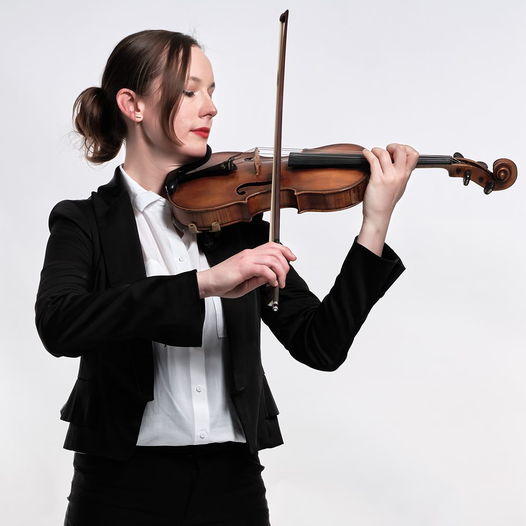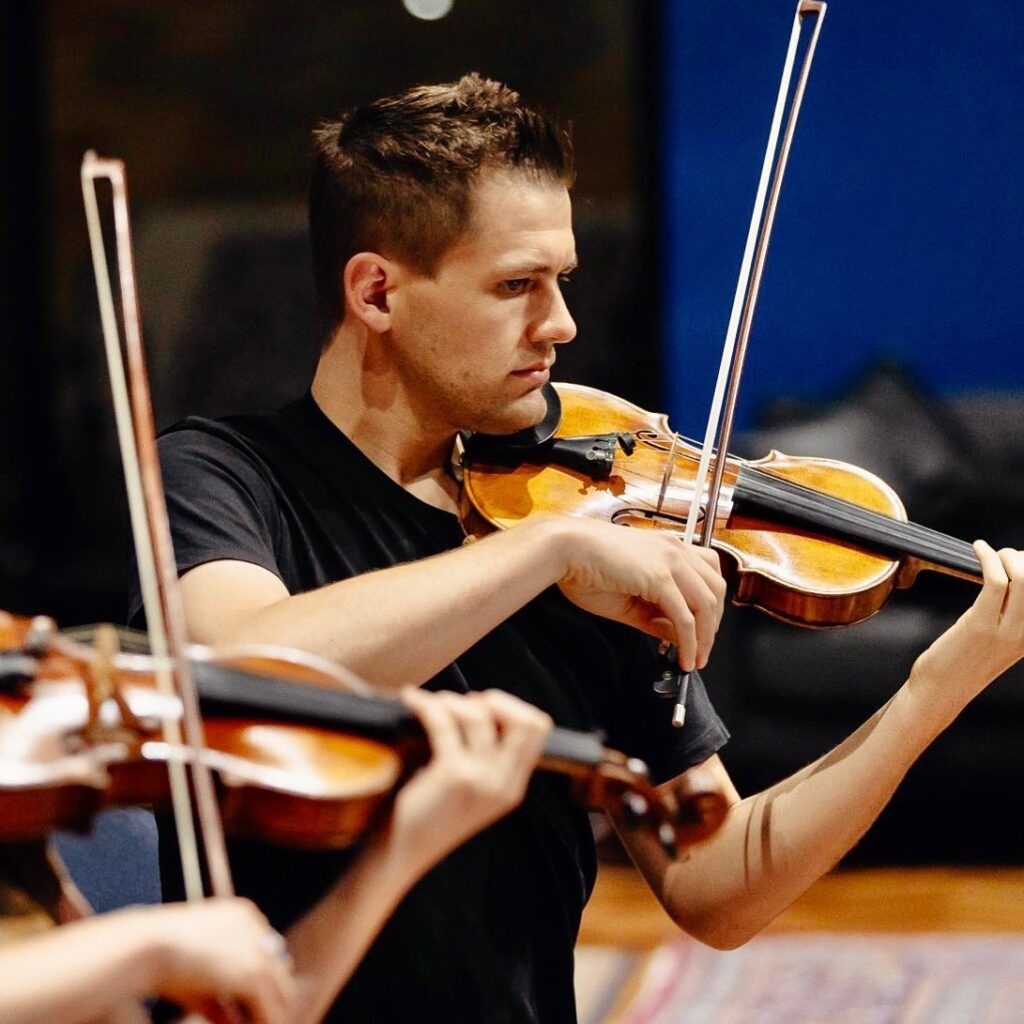Quintessence: an NZSQ Celebration Monique Lapins
Monique Lapins
 Peter Clark
Peter Clark
Concert introduced by Jeremy Johnson, Chairman of the New Zealand String Quartet Trust
BRAHMS – String Quartet No 3 in B-flat Major Op.67
Helene Pohl (leader), Monique Lapins (violin), Gillian Ansell (viola), Rolf Gjelsten (‘cello)
Farewell speech made by Monique Lapins, Second Violin of the New Zealand String Quartet
MOZART – String Quintet No.1 in B-flat major K.174
Helene Pohl (leader), Peter Clark (violin), Gillian Ansell (viola), Monique Lapins (viola), Rolf Gjelsten (‘cello)
Hunter Council Chamber, Victoria University of Wellington
Kelburn Parade, Wellington
Friday 7th June, 2024
It had to come – this was Monique Lapins’ final concert with the New Zealand String Quartet, marking her decision to move on after eight years spent as the group’s second violinist. With characteristic aplomb and due ceremony and not a little emotion, the process of change was here accorded appropriately bitter-sweet valedictory form by all of us who had gathered in the Hunter Council Chamber that evening. We were welcomed by Jeremy Johnson, Chairman of the New Zealand String Quartet Trust, who then paid the warmest of tributes to Monique regarding the significance and success of her tenure with the quartet before wishing her well, to which expression we all gave heartfelt accord.
Monique’s choice of repertoire as her “swan song” with the group was Brahms’s Third String Quartet, a kind of acme of expression for the ensemble, here given extra memorability by the circumstances.
Quartet leader Helene Pohl introduced the work for us, making due reference to the composer’s awareness of Beethoven and his legacy, and its “intimidating” factor for him. As Monique was to specifically mention the Beethoven cycle she had taken part in over the last eight years as a “career highlight” one understood the choice of Brahms as a kind of act of shared homage uniting composer and performer!
It did seem from the outset a kind of “master-class” of quartet-writing, with the composer obviously delighting in the contrasts between the opening “galloping” motiv sounded first in pairs, and then by the whole ensemble, the trajectories then being wreathed with almost insinuating diaphanous textures, and suggesting a Brahms with rather more impressionistic inclination than on previous occasions, as if stepping boldly into unknown territories. I loved the players’ voicings here, with Helene Pohl’s remarkable, almost “ghostly” tones darting around the others’ sombre impulses leading up to the almost artless dance-tune over which the cross-rhythms firstly send the players scurrying back to the beginning, and then dare those brave and bold enough to “sound out” the unknown territories before calling their bluff with some trenchant figurations. Masterly!
The second movement had Brahms in an almost “Salut d’amour” mood at its beginning, with ravishing playing of the opening theme from Helene Pohl, before a minor key-change heralded rather more forceful outbursts, tempered by thoughtful contributions from viola and ‘cello. Again, the quartet’s different voicings beautifully opened up for us these moments of impulse encircled by wonderment, and towards a disarming “Amen” at the movement’s close.
Surely the dark-toned Scherzo is one of the composer’s most compelling! – the players here drew us into its almost phantasmagorical world, right from Gillian Ansell’s hypnotic playing of the strangely lurching, almost anguished opening waltz-theme, embellished by the first violin, the music’s poise restored momentarily by a smilingly vigorous dance like major-key figure, and some hauntingly-played modulations into more wistful realms – enchanting, but precarious, with the viola all too ready to take up the agitato opening once again! We waited for the outcome of the exchanges between Gillian’s viola and Helene’s violin, with the viola prevailing and summonsing us onwards to the Trio. As well it might have, because in the beautifully circumspect Trio the viola at first “called the tune”, even if the violins did between them manage to grab some limelight – but what splendid focus the music gave to the instrument throughout this characterful movement right up to the end!
No better homage to Beethoven could have been devised here by Brahms than through the finale’s theme-and variations, a simple theme’s triplet rhythms cantering in and setting off a variety of characterful responses. How wonderful, though, after we’d welcomed these newcomers, was the sudden reappearance of the work’s opening, and for us to be able to warm to this “old friend” in the music, duly introduced to other characters from different parts of the work! After “who was who” had been sorted out, a brief coda proclaimed honour satisfied, and ended the work with a no-nonsense Brahmsian flourish!
After we’d expressed our heartfelt appreciation regarding the performance, it was, sadly, Monique Lapins’ turn to speak to us all regarding her “having come to the end” of her time with the New Zealand String Quartet, an experience which over the past eight years, she said, had been “the greatest honour” to share the performing stage with such wonderful colleagues, speaking of their “boundless energy, enthusiasm, rich musicality and unwavering commitment to music”. She also paid a warm tribute to the Quartet’s management team (regrettably Quartet Manager Aislinn Ryan couldn’t attend the concert because she had COVID) as well as to all the people who had made up the group’s “wonderful network of supporters” all of whom had helped make the experience for her such a rewarding one. She expressed a warm welcome to her successor, Peter Clark, wishing him well in his new adventure with the group of “making music together”. And with that, she invited the quartet members back onto the performing platform with their new second violinist, so that they could together perform one of Mozart’s most adorable works – the first of the composer’s String Quintets, K.174 in B-flat Major….
We’d previously heard a single movement of this work from the same group at the Quartet’s St Mary of the Angels concert last month (see review at https://middle-c.org/2024/05/18231/), but this time we were treated to the whole of the Quintet. It’s always been a favourite of mine, partly through an ongoing exchange of reactions with an old friend over the work’s opening, vis-à-vis the debatable issue of rhythm predominating over melodic line, or vice-versa (I’ve always plumped for the physical excitement of that driving rhythm, whereas he would “bliss out” over the violin’s soaring melody!). Here, I thought the two were well-nigh equally weighted, as the ensemble chose not to unduly “dig into” the initial notes as did the players on the recording I learned the work from (the Amadeus Quartet with Cecil Aronowitz, whose sound I continue to “hear” in my head as a kind of “template” whenever listening to anybody else play!).
Gorgeous “touches” abounded in this work, such as the introspective moments where individual lines muse and “call out” responses from other instruments, here sounding particularly thoughtful and wistful in places, the lovely duetting between two violas which added a unique colour to the sound, and the sections where the composer’s modulations have that naturally improvisatory flow that his contemporaries envied. The players further enchanted our sensibilities with the slow movement’s beautiful unison opening and the following “Serenata Notturna”-like exchanges, as they also did with the evocative “fairground” aspect of the Menuetto’s carnival-like opening, and the Trio’s beguiling echo effects.
But it was the finale that truly delighted us, especially with the scampering passagework, both canonic and in “unison thirds” from all the players, with some sequences resembling high-speed criss-crossings of trains on rail networks with nary a mishap! We particularly enjoyed the almost naughty incursion of triplets at one point, Mozart simply demonstrating that it could be done and without a misstep! Throughout, the players demonstrated in spadefuls that characteristic aspect of the ensemble, an all-encompassing enjoyment of the act of music-making together, one which Monique Lapins had emphasised in her tribute to her colleagues as perhaps the defining quality that had made her time with the quartet such a positive and memorable experience.
Having at the end of a previous review bade my farewells and good wishes already to Monique, I hesitate to awkwardly repeat myself – except to say that in regard to the evening, I thought her playing, her spoken tributes and her gracious relinquishing of her second violin role to her successor in concert all played a part in contributing to a response from all of us intended to express our warmest appreciation, heartfelt thanks and very best wishes towards her for her journey to come.